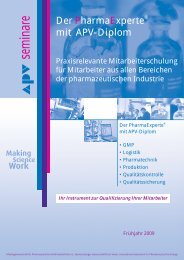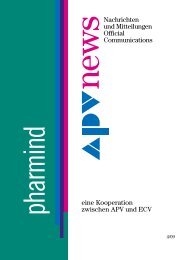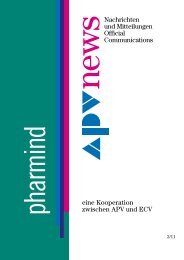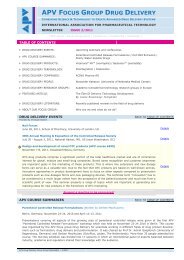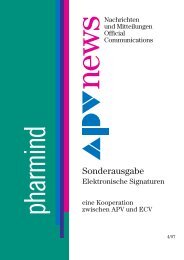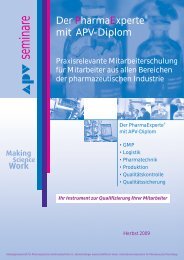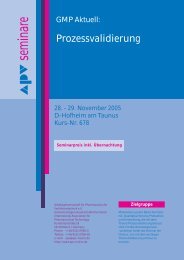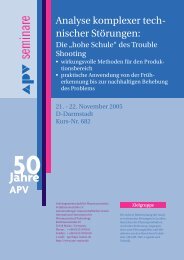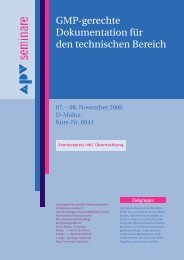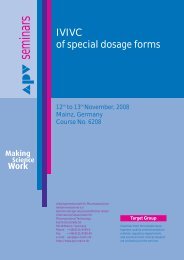New Technologies - APV
New Technologies - APV
New Technologies - APV
Create successful ePaper yourself
Turn your PDF publications into a flip-book with our unique Google optimized e-Paper software.
Micronised APIs in direct compression<br />
and ascorbic acid. Here, fewer areas suitable for the absorption of the API<br />
are present. The overall surface is less structured. A similar distribution on<br />
the carrier surface was determined for the hydrophobic model drug riboflavin<br />
(Fig. 6).<br />
Figure 6: Mixture of Parteck® M 200 with micronized riboflavin<br />
(drug load 1% w/w). Light microscope with 40x magnification.<br />
The yellow particles of API are clearly visible in the porosity of<br />
the carrier surface.<br />
The importance of the surface area and the pore volume of the additive for<br />
the homogeneity of the mixture was demonstrated. Next, the surface area<br />
and porosity of various additives for direct compression were analyzed<br />
using the BET method (nitrogen adsorption). Since the API is adsorbed to a<br />
porous surface, the observed differences between the excipients may give<br />
rise to different behavior in the adsorption of micronised APIs (Fig. 7).<br />
This study has shown that stable mixtures of much smaller micronized API<br />
particles with DC-excipients can be achieved. Is this suitable for a direct<br />
compression process in a real formulation?<br />
Figure 7: Comparison of the surface area and pore volumes of<br />
different excipients for direct compression.<br />
13 11<br />
<strong>New</strong> <strong>Technologies</strong><br />
R&D Case Study: Results from a Field<br />
Testing<br />
The question of whether low-dose pharmaceutical formulations with micronized<br />
API can be prepared by a DC process was tested using a watersensitive<br />
R&D-API at only 0.4% in the final dosage form (0.5 mg API in 120<br />
mg tablet). Wet granulation could not be applied, because of the watersensitivity<br />
of the API. So the micronized API (Dv50 10 µm) was premixed for<br />
30 minusing a Turbula® T2C shaker-mixer with 15% of the total amount of<br />
DC-grade mannitol Parteck® M (Dv50 200 µm), then mixed with the rest of<br />
the formulation (Fig. 8). A test run of 2 h on a Korsch Pharmapress PH230<br />
rotary press (Korsch AG, Berlin, Germany) was performed at two different<br />
rotation speeds (40’000 and 80’000 T/h). The tablets were assessed for<br />
their weight, hardness and disintegration time.<br />
This result was surprisingly good, as constant values were detected for<br />
tablet weight (RSD 0.6 – 0.9%), tablet hardness (RSD 4.1%) and disintegration<br />
time (Table 2). Content uniformity was measured to be ± 1.8 %.<br />
Figure 8: Composition of the pharmaceutical formulation used<br />
for the R&D case study.<br />
Table 2: Comparison of tablets manufactured at different speeds of the<br />
rotary press.<br />
Tablet weight<br />
Conclusion<br />
40‘000 Tablets/h 80‘000 Tablets/h<br />
120.1 mg (RSD<br />
0.6%)<br />
118.8 mg (RSD 0.9%)<br />
Tablet hardness 178 N (RSD 4.1%) 173 N (RSD 4.1%)<br />
Disintegration time 3'25'' 3'22''<br />
Although the concept of ordered mixtures has been extensively studied and<br />
reported [6,7,8,9], little was known about the underlying mechanisms and<br />
rationale. The results show clearly that the effect of ordered mixtures can<br />
be seen with DC-mannitols as a function of surface area and structure. The<br />
effect is greatest with for spray-dried qualities with a porous surface structure.<br />
A large surface area is necessary for a good binding capacity. Stable



